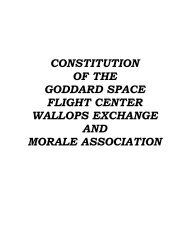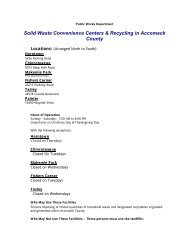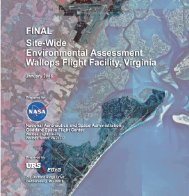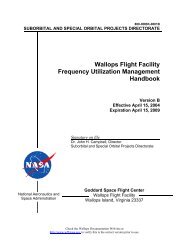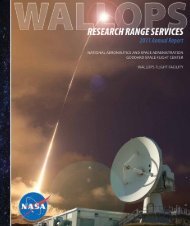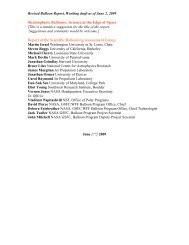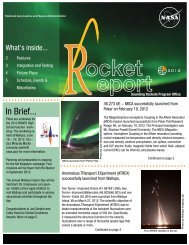NASA POKER FLAT EIS
NASA POKER FLAT EIS
NASA POKER FLAT EIS
Create successful ePaper yourself
Turn your PDF publications into a flip-book with our unique Google optimized e-Paper software.
APPENDIX D<br />
ALASKA NATIONAL INTEREST LANDS CONSERVATION ACT SECTION 810(A)<br />
SUMMARY OF EVALUATIONS AND FINDINGS
This page intentionally left blank.
APPENDIX D.<br />
ALASKA NATIONAL INTEREST LANDS CONSERVATION ACT<br />
SECTION 810(A) SUMMARY OF EVALUATIONS<br />
AND FINDINGS<br />
D.1 INTRODUCTION<br />
This summary of evaluations and findings has been prepared to comply with the requirements<br />
incumbent upon the U.S. Fish and Wildlife Service and Bureau of Land Management as<br />
established by Title VIII, Section 810, of the Alaska National Interest Lands Conservation Act<br />
(ANILCA). It evaluates the potential restrictions on subsistence activities that could result from<br />
implementation of the alternatives considered in the National Aeronautics and Space<br />
Administration (<strong>NASA</strong>’s) Draft Environmental Impact Statement for the Sounding Rockets<br />
Program at Poker Flat Research Range (PFRR <strong>EIS</strong>).<br />
As described in this environmental impact statement (<strong>EIS</strong>), the <strong>NASA</strong> Sounding Rockets<br />
Program (SRP) has conducted missions from Poker Flat Research Range (PFRR) in interior<br />
Alaska since the late 1960s. This <strong>EIS</strong> evaluates four action alternatives that include continuation<br />
of the SRP at PFRR with varying amounts of search and recovery to retrieve payloads and spent<br />
rocket stages. This <strong>EIS</strong> also evaluates a No Action Alternative, in which SRP operations,<br />
including launches and subsequent search and recovery efforts, would continue as currently<br />
conducted.<br />
Chapters 3 and 4 of this <strong>EIS</strong> provide a detailed description of the baseline conditions and the<br />
potential adverse effects on subsistence of the alternatives. The analysis in this appendix<br />
leverages the detailed information presented in this <strong>EIS</strong> to evaluate the potential impacts on<br />
subsistence pursuant to Section 810(a) of ANILCA.<br />
D.2 THE EVALUATION PROCESS<br />
Section 810(a) of ANILCA states:<br />
“In determining whether to withdraw, reserve, lease, or otherwise permit the use,<br />
occupancy, or disposition of public lands…the head of the Federal agency…over<br />
such lands…shall evaluate the effect of such use, occupancy, or disposition on<br />
subsistence uses and needs, the availability of other lands for the purposes sought<br />
to be achieved, and other alternatives which would reduce or eliminate the use,<br />
occupancy, or disposition of public lands needed for subsistence purposes. No<br />
such withdrawal, reservation, lease, permit, or other use, occupancy or disposition<br />
of such lands that would significantly restrict subsistence uses shall be affected<br />
until the head of such Federal agency:<br />
1. gives notice to the appropriate State agency and the appropriate local<br />
committees and regional councils established pursuant to Section 805;<br />
SEPTEMBER 2012 D–1
Draft Environmental Impact Statement for the Sounding Rockets Program at Poker Flat Research Range<br />
2. gives notice of, and holds, a hearing in the vicinity of the area involved; and<br />
3. determines that (a) such a significant restriction of subsistence uses is<br />
necessary, consistent with sound management principles for the utilization of<br />
the public lands, (b) the proposed activity would involve the minimal amount<br />
of public lands necessary to accomplish the purposes of such use, occupancy,<br />
or other disposition, and (c) reasonable steps would be taken to minimize<br />
adverse impacts upon subsistence uses and resources resulting from such<br />
actions.”<br />
To determine if a significant restriction of subsistence uses and needs may result from any one of<br />
the alternatives discussed in this <strong>EIS</strong>, the following three factors in particular are considered:<br />
A reduction in subsistence uses due to factors such as direct impacts on the resource,<br />
adverse impacts on habitat, or increased competition for the resources;<br />
A reduction in the subsistence uses due to changes in the availability of resources caused<br />
by an alteration in their distribution, migration, or location; and<br />
A reduction in subsistence uses due to limitations on the access to harvestable resources<br />
such as physical or legal barriers.<br />
Subsistence evaluations and findings under ANILCA Section 810 also must consider cumulative<br />
impacts. In the context of this evaluation, cumulative impacts are additive limitations on<br />
subsistence uses or resources caused by the proposed alternatives when considered within the<br />
context of past, present, and future activities affecting those same uses or resources. Cumulative<br />
impacts are discussed in Chapter 4, Section 4.1.5, of this <strong>EIS</strong>.<br />
When analyzing the effects of the five alternatives, those villages that may harvest subsistence<br />
resources within or adjacent to the PFRR flight zones are considered (see Section D.4, below).<br />
D.3 PROPOSED ACTION ON FEDERAL LANDS<br />
Chapter 2 of this <strong>EIS</strong> (“Description and Comparison of Alternatives”) describes in detail the<br />
alternatives under consideration. Following is a brief summary of each. The primary focus of<br />
activity would take place within the PFRR flight zones, which include Federal, state, and Tribal<br />
lands.<br />
Under either alternative, the use of Federal lands would be required for the landing and recovery<br />
of flight hardware. As such, the U.S. Fish and Wildlife Service (USFWS) and the U.S. Bureau of<br />
Land Management would be required to respond to a request for such authorization, thereby<br />
taking an action connected to those alternatives proposed by <strong>NASA</strong> below.<br />
D–2 SEPTEMBER 2012
D ▪ ANILCA Section 810(a) Summary of Evaluations and Findings<br />
D.3.1 No Action Alternative – Continue <strong>NASA</strong> SRP at PFRR in its Present Form<br />
and at the Current Level of Effort<br />
Under the No Action Alternative, the SRP activities at PFRR would continue in their present<br />
form and at the current level of effort (approximately four launches per year). <strong>NASA</strong> would<br />
continue to avoid the Mollie Beattie Wilderness Area within Arctic NWR. Under this<br />
alternative, no significant efforts would be taken to recover spent stages unless desired for<br />
programmatic reasons, and payloads would be recovered as planned by the scientists. See<br />
Chapter 2, Section 2.3.1, of this <strong>EIS</strong>, for a full description of this alternative.<br />
D.3.2 Alternative 1 – Continue <strong>NASA</strong> SRP Activities and Flights at PFRR within<br />
Existing Flight Zones, with Environmental Screening for Recovery of New<br />
and Existing <strong>NASA</strong> Stages and Payloads (Environmentally Responsible<br />
Search and Recovery Alternative)<br />
Alternative 1 would continue <strong>NASA</strong> SRP launch and recovery operations at PFRR as in the<br />
recent past with enhanced efforts to track and locate existing spent stages and payloads.<br />
Launches would average 4 per year with a maximum of 8 per year. Attempts would be made to<br />
recover newly expended stages and payloads within the PFRR flight corridor. Spent stages and<br />
payloads would be recovered in an environmentally responsible manner if it is determined that<br />
they can be recovered safely. See Chapter 2, Section 2.3.2, of this <strong>EIS</strong>, for a full description of<br />
this alternative.<br />
D.3.3 Alternative 2 – Continue <strong>NASA</strong> SRP Activities and Flights at PFRR within<br />
Existing Flight Zones, with Removal of Spent Stages and Payloads<br />
(Maximum Cleanup Search and Recovery Alternative)<br />
Alternative 2 is the same as Alternative 1, except maximum practicable effort would be exerted<br />
to recover newly expended and existing spent stages from downrange lands if it is determined<br />
that they can be recovered safely, even if the efforts result in some long-term environmental<br />
impacts. See Chapter 2, Section 2.3.3, of this <strong>EIS</strong>, for a full description of this alternative.<br />
D.3.4 Alternative 3 – Continue <strong>NASA</strong> SRP Activities and Flights at PFRR with<br />
Restricted Trajectories to Reduce Impacts on Designated Environmentally<br />
Sensitive Areas (Environmentally Responsible Search and Recovery<br />
Alternative with Restricted Trajectories)<br />
Alternative 3 is the same as Alternative 1, except trajectories of future <strong>NASA</strong> launches would be<br />
restricted to reduce the possibility of stages or payloads landing within areas identified as<br />
environmentally sensitive, such as designated Wilderness or Wild and Scenic Rivers. See<br />
Chapter 2, Section 2.3.4, of this <strong>EIS</strong>, for a full description of this alternative.<br />
SEPTEMBER 2012 D–3
Draft Environmental Impact Statement for the Sounding Rockets Program at Poker Flat Research Range<br />
D.3.5 Alternative 4 – Continue <strong>NASA</strong> SRP Activities and Flights at PFRR with<br />
Restricted Trajectories to Reduce Impacts on Designated Environmentally<br />
Sensitive Areas (Maximum Cleanup Search and Recovery Alternative with<br />
restricted Trajectories)<br />
Alternative 4 would be the same as Alternative 2, except trajectories of future PFRR missions<br />
would be restricted to reduce the possibility of payloads or stages landing within areas identified<br />
as environmentally sensitive, such as designated Wilderness or Wild and Scenic Rivers. See<br />
Chapter 2, Section 2.3.5, of this <strong>EIS</strong>, for a full description of this alternative.<br />
D.4 AFFECTED ENVIRONMENT<br />
The region of influence (ROI) for subsistence use resources includes communities under or<br />
within 37 kilometers (20 nautical miles) of the PFFR launch site and flight corridor. These<br />
communities include Arctic Village, Beaver, Birch Creek, Central-Circle Hot Springs,<br />
Chalkyitsik, Circle, Coldfoot, Fort Yukon, Kaktovik, Livengood, Stevens Village, Venetie, and<br />
Wiseman. The ROI includes these areas because there are communities directly under the PFRR<br />
flight zones or ones that may travel into the areas beneath the flight zones to harvest subsistence<br />
resources in response to wildlife or vegetation availability (see Figures D–1 through D–9 for<br />
composite subsistence use maps for the larger communities). A distance of 37 kilometers<br />
(23 miles) was used as a best estimate for the maximum distance traveled without the use of<br />
aircraft to harvest subsistence resources. Detailed characteristics of these communities and the<br />
Game Management Units (GMUs) in which these communities are located and characteristics of<br />
the Federal and state subsistence uses, are provided in Chapter 3, Section 3.10, Table 3–17, of<br />
this <strong>EIS</strong>.<br />
The PFRR launch site is within the Fairbanks North Star Borough, which is considered a<br />
nonrural area under Federal subsistence regulations and a non-subsistence area under State<br />
regulations. Therefore, it is assumed that subsistence activities are not conducted in the<br />
immediate vicinity of the PFRR launch site.<br />
D–4 SEPTEMBER 2012
. Ra mpart<br />
D ▪ ANILCA Section 810(a) Summary of Evaluations and Findings<br />
WId_ • ..,...,,, [Z] ..... "..,.w_ .... _<br />
• ..." .... "'."-'lR.,_ r::I "*on,..,1Wld h R"_<br />
c ,. ""ov.""." ... ...,. ... _.<br />
V/ildlife Refuge<br />
\ .<br />
,<br />
St H"" Not1.Cou Ar ••<br />
Figure D–1. Primary Subsistence Use Area Surrounding Arctic Village<br />
SEPTEMBER 2012 D–5<br />
"<br />
•<br />
Beaufort Sea<br />
( Arctic Ocean)<br />
,ro o<br />
e.._
Draft Environmental Impact Statement for the Sounding Rockets Program at Poker Flat Research Range<br />
w .. _ • ..,...,_ [2]W .. "..,.W--. . ....<br />
. Wh .... n>.""n _ _ D"*on,..,1W ...... RoI_<br />
D ""' •• R ...... otOn eo-o"". ,,
Draft Environmental Impact Statement for the Sounding Rockets Program at Poker Flat Research Range<br />
Arctic ,Nall'L'I. Wildlife Refuge<br />
i",<br />
Cifde Hot Springs Q<br />
. "<br />
St .... Not1 .Cou Area<br />
Figure D–6. Primary Subsistence Use Area Surrounding Kaktovik<br />
Beaufort Sea<br />
(Arctic Ocean)<br />
• ,ro ()<br />
D–10 SEPTEMBER 2012
Draft Environmental Impact Statement for the Sounding Rockets Program at Poker Flat Research Range<br />
Available Resources<br />
Within the PFFR launch corridor, many subsistence based communities rely on fishing for both<br />
salmon and non-salmon species, and hunting and trapping large and small land mammals, and a<br />
variety of bird species. Fish is one of the most reliable sources of meat that can be harvested<br />
nearly year-round either through nets or ice fishing. The Yukon River, the Chandalar River, the<br />
Black River, and the Porcupine River are main providers of salmon species (Caulfield 1983). A<br />
number of other lakes and creeks within the PFRR flight zones provide non-salmon species.<br />
Land mammals such as caribou, moose, and Dall sheep in particular are used as sources of meat.<br />
These species are often hunted by boat or snowmachine as they are usually found in close<br />
proximity to rivers. Furbearers, including muskrat, lynx, beaver, and wolf are commonly<br />
pursued for use in traditional garments. Waterfowl are hunted as food sources, particularly in the<br />
spring and early fall months. Marine mammals can be harvested for subsistence purposes, but<br />
only by Alaska Natives, as permitted in the Marine Mammals Protection Act (16 U.S.C. 1361 et<br />
seq.). The regulations governing subsistence harvests of marine mammals are co-managed by<br />
Alaska Natives, USFWS, and the National Marine Fisheries Service. In addition to caribou, Dall<br />
sheep, small mammals, migratory birds, and fish, the Kaktovik community is dependent on the<br />
subsistence hunting of marine mammals, including bowhead whale, bearded seal, ringed seal,<br />
and occasionally polar bears (Bacon et al. 2009).<br />
Seasonality of Activities<br />
Harvesting vegetation such as berries or other roots or vegetables typically occurs in late summer<br />
as the vegetation ripens. Subsistence hunting and trapping are regulated by the hunting and<br />
trapping seasons established by species. These seasons can vary among the GMUs and between<br />
Federal and state regulations, depending on the population of the species in question. For<br />
example, on Federal and state lands, there is no closed season for black bears in GMU-25<br />
(ADF&G 2011; USFWS 2010a). For caribou, open season in GMU-25 is different, depending<br />
on the GMU subunit. In portions of GMU-25A, there is no closed season for hunting caribou<br />
bulls; however, hunting caribou cows is not permitted between early July and mid-May<br />
(ADF&G 2011; USFWS 2010a). Therefore, subsistence activities occur year-round, depending<br />
on the open seasons and availability of the variety of vegetation and wildlife species harvested.<br />
Geographic Extent of Activities<br />
As a component of previously conducted studies, several of the villages within the PFRR flight<br />
corridor have identified areas within which subsistence activities would be expected on a regular<br />
basis. Maps of the various subsistence use areas for the larger villages included in this appendix<br />
(Figures D–1 through D–9) were identified during the Yukon Flats Land Exchange Final <strong>EIS</strong><br />
(USFWS 2010b) and the Arctic National Wildlife Refuge Draft Revised Comprehensive<br />
Conservation Plan (USFWS 2011). These areas are defined by a number of factors including<br />
habitat and migration patterns of the wildlife and accessibility of the areas to individuals<br />
participating in subsistence. It is recognized that these do not likely represent the full geographic<br />
extent of subsistence activities within the ROI; however, they can be viewed in relation to the<br />
“typical” impact areas of spent stages and payloads to identify the communities mostly likely<br />
affected. Of these subsistence use areas, the areas for Arctic Village, Beaver, Fort Yukon, and<br />
D–14 SEPTEMBER 2012
D ▪ ANILCA Section 810(a) Summary of Evaluations and Findings<br />
Venetie overlap probable impact points for spent stages and payloads. As a result, subsistence<br />
activities conducted by residents in these villages are more likely to experience potential impacts<br />
as a result of continued launches from PFRR. Information on subsistence use areas associated<br />
with the smaller villages or towns (Coldfoot, Chandalar, and Livengood) is not readily available<br />
but it is likely that the Chandalar use area would overlap with probable impact points and that the<br />
Coldfoot use area would be similar to the Wiseman subsistence use area given the proximity of<br />
the two.<br />
D.5 SUBSISTENCE USES AND NEEDS EVALUATION<br />
In 1980, Congress established a framework for protecting subsistence uses by both Native<br />
Alaskans and non-Native Alaskans in Title VIII of ANILCA. Title VIII authorizes the State of<br />
Alaska to regulate subsistence uses on Federal public lands if several requirements are met.<br />
The State of Alaska managed statewide subsistence harvests until late 1989, when the Alaska<br />
Supreme Court ruled that the residency preference required by Federal law violated the Alaska<br />
Constitution. The state was unable to come into compliance and on July 1, 1990, the Federal<br />
Government assumed responsibility for the management of subsistence taking of wildlife on<br />
Federal public lands in Alaska. Further litigation and court decisions resulted in the<br />
October 1, 1999, assumption of Federal subsistence fisheries management in Alaskan rivers and<br />
lakes within and adjacent to Federal public lands.<br />
The Federal Government, through the Federal Subsistence Board, manages subsistence use of<br />
fish and wildlife resources on Federal lands, and the State of Alaska, through the Boards of<br />
Fisheries and Game, manages general subsistence and commercial use of fish and wildlife<br />
resources on non-federal lands and National Preserve lands open to multiple use. The Federal<br />
and state management systems operate under individual legislation and enforce separate<br />
regulations.<br />
Both Federal and state laws define subsistence as the “customary and traditional” uses of wild<br />
resources for food, clothing, fuel, transportation, construction, art, crafts, sharing, and customary<br />
trade. Customary and traditional uses of fish and game are important to Alaskans from diverse<br />
cultural backgrounds.<br />
Federal and state law differs in who qualifies for subsistence uses. Under Federal law, only local<br />
rural residents and communities with customary and traditional use of Federal lands qualify for<br />
subsistence fishing and hunting on Federal lands. Currently, all state residents qualify for<br />
subsistence fishing and hunting under state law.<br />
Within the PFRR flight zones, Federal subsistence use is permitted on federally-owned land and<br />
state subsistence use is permitted on state-owned land. For Alaskan native land, such as the land<br />
owned by Doyon, Limited, subsistence use is permitted under state regulations, but Doyon,<br />
Limited, controls access to the lands. On federally owned land, state general hunting is also<br />
allowed unless specifically closed by federal law.<br />
SEPTEMBER 2012 D–15
Draft Environmental Impact Statement for the Sounding Rockets Program at Poker Flat Research Range<br />
D.5.1 Potential Impacts on Subsistence<br />
Potential impacts on subsistence from the alternatives considered in this <strong>EIS</strong> include impacts on<br />
wildlife and the harvest of wildlife from the noise and disturbance created by the launch and reentry<br />
of the sounding rockets and the fixed-wing aircraft and helicopters used in the search and<br />
recovery operations. Impacts on subsistence would depend on the level of intensity and duration<br />
of these disturbances.<br />
D.5.2 Evaluation Criteria<br />
To determine the potential impacts of the alternatives on existing subsistence activities, three<br />
evaluation criteria were analyzed relative to existing subsistence resources:<br />
1. The potential to reduce important subsistence fish and wildlife populations by<br />
(a) reductions in number, (b) redistribution of subsistence resources, or (c) habitat losses;<br />
2. What effect the action might have on subsistence fisher or hunter access;<br />
3. The potential for the action to increase fisher or hunter competition for subsistence<br />
resources.<br />
D.5.2.1 The Potential to Reduce Populations<br />
Reduction in Numbers<br />
Neither the direct, indirect, or cumulative impacts resulting from the alternatives considered in<br />
this <strong>EIS</strong> are expected to reduce numbers of wildlife (see Chapter 4, Sections 4.7, 4.10, and 4.15<br />
of this <strong>EIS</strong>).<br />
Redistribution of Resources<br />
Neither the direct, indirect, or cumulative impacts resulting from the alternatives considered in<br />
this <strong>EIS</strong> are expected to permanently redistribute resources. Disturbance caused by noise from<br />
low-flying aircraft may cause terrestrial wildlife to temporarily vacate the overflown area.<br />
However, the wildlife species are expected to return to the area once the source of the noise has<br />
left the area (see Chapter 4, Sections 4.7, 4.10, and 4.15 of this <strong>EIS</strong>).<br />
Habitat Loss<br />
Neither the direct, indirect, or cumulative impacts resulting from the alternatives considered in<br />
this <strong>EIS</strong> are expected to result in measurable habitat loss. Only small disturbances of land,<br />
water, or vegetation would result; such impacts would be confined to the footprint of where<br />
flight hardware would land and recovery activities would occur (see Chapter 4, Sections 4.7,<br />
4.10, and 4.15 of this <strong>EIS</strong>).<br />
D–16 SEPTEMBER 2012
D.5.2.2 Restriction of Access<br />
D ▪ ANILCA Section 810(a) Summary of Evaluations and Findings<br />
None of the alternatives would restrict access for subsistence.<br />
D.5.2.3 Increase in Competition<br />
None of the alternatives are expected to result in increased competition for subsistence resources.<br />
D.6 AVAILABILITY OF OTHER LANDS<br />
No other lands can be substituted in the alternatives. A detailed discussion of consideration of<br />
other launch sites or trajectories is located within Section 2.2.1 and Appendix B of this <strong>EIS</strong>.<br />
D.7 FINDINGS<br />
This analysis concludes that neither of the alternatives under consideration would result in a<br />
significant restriction of subsistence users, resources, or opportunities.<br />
D.8 REFERENCES<br />
Caulfield, R.A., 1983, Subsistence Land Use in Upper Yukon Porcupine Communities, Alaska.<br />
Dinjii Nats’aa Nan Kak Adagwaandaii, Technical Paper Number 16, June.<br />
Bacon, J.J., Hepa T.R., Brower, Jr., H.K., Pederson, M., Olemaun, T.P., George, J.C., and<br />
Corrigan, B.G., 2009, Estimates of Subsistence Harvest for Villages on the North Slope of<br />
Alaska, 1994–2003, December.<br />
ADF&G (Alaska Department of Fish and Game), 2011, 2011–2012 Alaska Hunting Regulations,<br />
effective July 1, 2011, to June 30, 2012.<br />
USFWS (U.S. Fish and Wildlife Service), 2010a, Subsistence Management Regulations for the<br />
Harvest of Wildlife on Federal Public Lands in Alaska, Effective July 1, 2010 – June 30, 2012,<br />
http://alaska.fws.gov/asm/law.cfml?law=2&wildyr=2010, July.<br />
USFWS (U.S. Fish and Wildlife Service), 2010b, Proposed Land Exchange Yukon Flats<br />
National Wildlife Refuge Final Environmental Impact Statement, Alaska Regional Field Office,<br />
accessed through http://yukonflatseis.ensr.com/yukon_flats/documents_F<strong>EIS</strong>.htm on<br />
August 22, 2011.<br />
USFWS (U.S. Fish and Wildlife Service), 2011, Arctic National Wildlife Refuge, Draft Revised<br />
Comprehensive Conservation Plan, Draft Environmental Impact Statement, Wilderness Review,<br />
Wild and Scenic River Review, Volume 1, June.<br />
United States Code<br />
16 U.S.C. 1361 et seq., Marine Mammal Protection Act.<br />
SEPTEMBER 2012 D–17
This page intentionally left blank.



